In 1638, the British established a colony on the southern coast of Roatan. Officially, the settlers of Old Port Royal were directed to harvest timber from the forested slopes of the island. Unofficially, the colonists invested quite a bit of time in piracy — Spanish galleons loaded with Central American treasure were frequently intercepted and ambushed, and the treasure often never left the Caribbean.
After the increasingly annoying — and very costly — raids became too much for the Spanish crown to tolerate, the Spanish navy showed up in 1650 and wiped Old Port Royal off the map. In time, the settlement would come back, but the Spanish rebuke taught Roatan’s pirates a vital lesson — their craft needed to be practiced in secret.
Instead of brazen piracy, Roatan’s outlaws retreated to the hidden cays and deep-water coves of the island. They took refuge in the mountains and carved mazes in the mangrove swamps — these illicit highways still exist today (and they’re still used by locals to get around).
In the mid-1600s, Roatan was home to some of the most infamous buccaneers in history. The vile Edward Teach — known to most simply as Blackbeard — used the island as a sanctuary and hideout. In the 1660s and 1670s, Sir Henry Morgan (the namesake for some pretty average spiced rum, unfortunately) became one of the most successful “privateers” in the Caribbean, where, sanctioned by the British crown, he became something of a legal pirate in the waters around Roatan.
Then there was John Coxen, the namesake of the community visiting tourists see first after disembarking from Roatan’s international airport. Coxen, over the course of his career as a pirate, conducted daring raids on Spanish strongholds throughout the region in the mid- to late 1600s, and he was beloved by his crews. Roatan provided safety for the infamous buccaneer, and sometime after being captured and later pardoned by the governor of Jamaica in 1688, Coxen, his eight-gun ship and his crew simply disappeared. To this day, the locals of Roatan say he and his mates occupy an exalted corner of Davy Jones’ locker.
The British and the pirates they spawned weren’t the first colonial influence on Roatan. Christopher Columbus, sailing for Spain, arrived on the Bay Islands in 1502. Over time, the island endured the imperial shackles of Britain, Spain, France and the Netherlands as they all fought to reap the bounty of the New World.
But it’s the pirate lore that lingers.
The island some 30 miles off the coast of Honduras still gives up buried treasure from time to time in the form of old pirate swords, historic trinkets and other items that turn up for would-be treasure hunters. There’s a certain romance to the stories the locals still tell, and the secret water trails through the mangroves or the old pirate hideouts in the mountains are a testament to the island's rich and colorful past.
Not surprisingly, given Roatan’s robust maritime past, the deep, blue waters off this stunning and somewhat self-governed island boast some of the best wreck diving in the world — Roatan is renowned for its stunning reefs and numerous shipwrecks that span some 500 years.
Populated by a colorful lot of characters originating from Spanish, English, Dutch and French occupiers and imprisoned West African slaves who were brought to the island and then largely abandoned, Roatan has earned its place as a cultural melting pot in the Caribbean. No individual Roatanian looks quite like another, and Creole culture is dominant. Even though Spanish is the official language of Honduras, most Roatanians speak English laced with a heavy dose of Creole thrown in, just to make it interesting.
And, while diving and snorkeling have proven to be exactly what the little island needs to kind of keep its economy lively and somewhat separated from the less gentrified environment on the Honduran mainland, another group of adventurers continues to discover what the wetsuit crowd has known for decades.
Roatan possesses another silvery treasure — its metallic tarpon, chrome-bright bonefish and shiny schools of hunting permit are catching the eyes of fly fishers the world over.
Roatan is fishy. Very fishy.

Permit by the dozen
“You see them, right?” Michael Bodden asked as he pointed off into the distance, the sun at our backs. The turtle grass on the flat left me completely baffled. How this kid at my side could delineate between the dark, green bottom and the dark backs of the approaching school of permit without the help of polarized sunglasses was beyond me. I had polarized lenses, and I’ve been fishing the tropics for more than a dozen years, during which I thought I’d honed a pretty solid fisheye — and I wasn’t seeing anything
“Tell me what you’re looking at,” I said quietly. Then, about 80 feet away, a sickle-shaped tail sliced through the water and I tensed the way all fly fishers do when they’re about to get a legit permit shot.
“You saw that, right?”
“I did see that.”
“That’s a big school,” Michael said. “That’s a lot of fish. We’re going to get one.”
We arrived just as a borderline historic week of gale-force winds engulfed the entire Caribbean, all the way from Roatan’s shores north to Cuba. This was our third morning of braving the “outside” waters to get to this little flat on the southeast side of Roatan. Our third morning of waking up as dawn knocked, guzzling coffee and then meeting Michael at the dock behind our comfortable little beachfront villa before the sun cleared the sea. Our third morning of riding in Michael’s unsinkable panga over angry ocean rollers into the pale morning sky. And it was the third morning that I’d still not seen the permit I was casting to.
Then, as if I had been paying my dues on this skinny stretch of turtle grass miles from anywhere, I started to see what Michael seems to see all the time. I saw the fish pushing through the water, and not just the tell-tale dorsal or tail fin. I saw shapes and shadows and that angry permit face as it contemplates its next meal while still in some inexplicable rush to get wherever it is permit go when they’re not right in front of you mocking your crappy cast or your clunky presentation.
And, I don’t think it’s a coincidence that this is when my cast suddenly found its target and I started hooking up. By the end of the morning session on that third day, I’d managed to connect with several permit, fight two of them and bring one to hand. More importantly, we saw likely hundreds of fish in schools of 10 to 12 literally from the moment we set foot on the flat to when we called it quits for lunch. It was a good day on the flats for any permit addict.

Respectable bones
This corner of the Caribbean isn’t known for giant bonefish, but the east end of Roatan might prove to be the exception to the rule. Farther north in Belize and along the southern Yucatan of Mexico, a nice bonefish might be about four pounds. During our week-long experience fishing out of Oak Ridge on the southeast coast of Roatan, the bonefish were a bit larger on average and we laid eyes on some really nice fish.
But, the size of the fish aside, it’s also a very unique bonefishing experience. Certainly, bones and permit share the same flats on the far-flung east end of the island. But, in more gentrified areas of the island, the bones have adapted — and, dare I say, thrived — among the development.
How so?
When we showed up at the seaside villa that was to be our home for the next week, one of the first things we noticed as we looked out over the marly beach was a school of bonefish frolicking in the soft waves not 200 feet from the porch where we stood. While there are plenty of big, sweeping bonefish flats along the reef at the island’s east end that are totally worth a half-hour boat ride to reach, the “beach bones” that poke up out of the blue water and frolic in the gentle Caribbean surf, are a blast to chase.
That's because they’re not tailing on “typical” flats — the constant, yet mild, tidal action on calmer days helps break up the water a bit. This results in bonefish that are not as overtly wary as most bones I’ve cast to in the past. It meant shorter, more accurate casts and fish that didn’t spook so badly if a cast ended up right on top of the fish.
Dare I say, beach bones are more forgiving than the fish I’m more accustomed to chasing on sand and grass flats from the Bahamas to Belize. And, if anyone can appreciate a forgiving bonefish, it’s me.
One very windy morning, rather than brave the outside ride to the permit flat, Michael took us west a bit, using the island’s inside channels that were carved years ago — sometimes centuries ago by pirates and privateers — where we literally played a thrilling game of “spot-and-stalk” with some very big bones against a totally unique backdrop. To the south, the vast Caribbean opened up before us, and the blue water started within just a few feet of the wave break. Toward the shore, the island’s natural gas receiving station stood sentinel over the flat we were fishing, just across the shipping channel from us.
It was quite the juxtaposition, honestly, but everything on Roatan’s east end is very real — the island community doesn’t hide its underbelly. Not even for visiting fly fishers. And, I can say with absolute honesty, the fishing was really good. It was a testament to how an excellent inshore sport fishery can co-exist with the daily lives of Roatan’s big-smiling islanders.
Boat-basin tarpon
Roatan is home to resident tarpon, and the bigger, migratory fish are summer staples in the region. But in the spring, fish from 25 pounds on up to 100-pound behemoths tend to gather in the island’s boat basins and mangrove coves, and fly fishers can do very well chasing them among the docked yachts and even fishing boats and transport vessels.
Certainly, the big fish hang out in the mangrove bays and the cut channels, but watching a dozen rolling tarpon while you’re slowly motoring through a busy ship channel is pretty cool.

It might seem like an odd setting — and I’d compare the experience to chasing tarpon, snook and redfish among the dock lights of Tampa Bay — but it’s a very interesting fishery. And,
If you're a tarpon purist, there are places on Roatan where you can experience generally the same thing, minus the man-made chaos.
The “X-factor”
From our little beachfront retreat, we sometimes eschewed the fishing and opted for something totally different. One evening, we loaded a cooler full of Salva Vida cerveza and hopped into a water taxi for a tour of the island’s historic mangrove channels. We docked at one of several waterfront bars accessible only by boat, where we sipped rum and Cokes and took in the island’s unique vibe.
In the evenings, after dinner, we’d often wander next door to the little outdoor bar at the Reef House, where locals and expats gather to drink and chat and check in with the Coconut Telegraph. Later in the trip, rather than belly up to the bar, we hopped aboard the island’s tiki boat for a sunset cruise.

One afternoon, we joined Michael on a rather unique adventure to Pigeon Cay, on the east end of the island. Michael guided the villa’s twin-outboard cruiser to a remote cluster of sandy shallow shoals, and started tossing baitfish into the water. Within seconds, a half-dozen lemon sharks and a host of eagle rays showed up to devour the fish.
Then, we donned snorkels and fins and plunged into the crystal clear waters, where, sometimes within mere inches, we were able to watch the big fish do their thing. It was a bit unnerving at first, but, after a few minutes of watching the sharks and rays, we didn’t want to quit, even as darkness approached.
All of this, of course, speaks to the wonders of Roatan. Sure, it’s fishy and us fly anglers can’t let the divers have all the fun. But it’s no wonder this little-known corner of the Caribbean continues to find favor among adventurous travelers and digital nomads looking for something totally unique.
Roatan’s “discovery” was centuries ago. And its treasure still lingers.




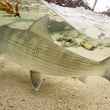
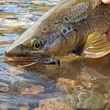
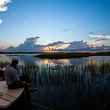





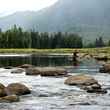



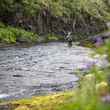
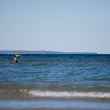



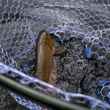
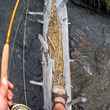



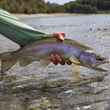


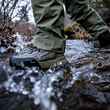


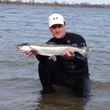
Comments